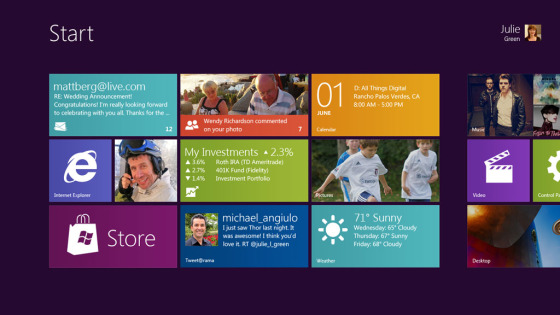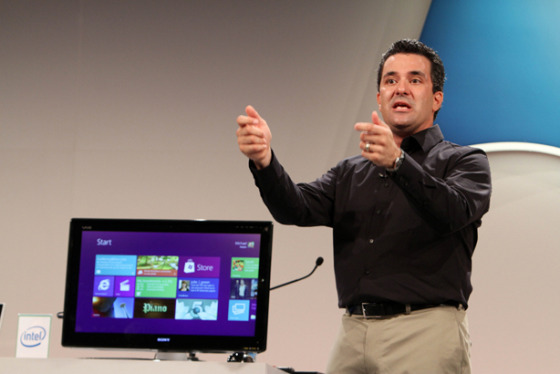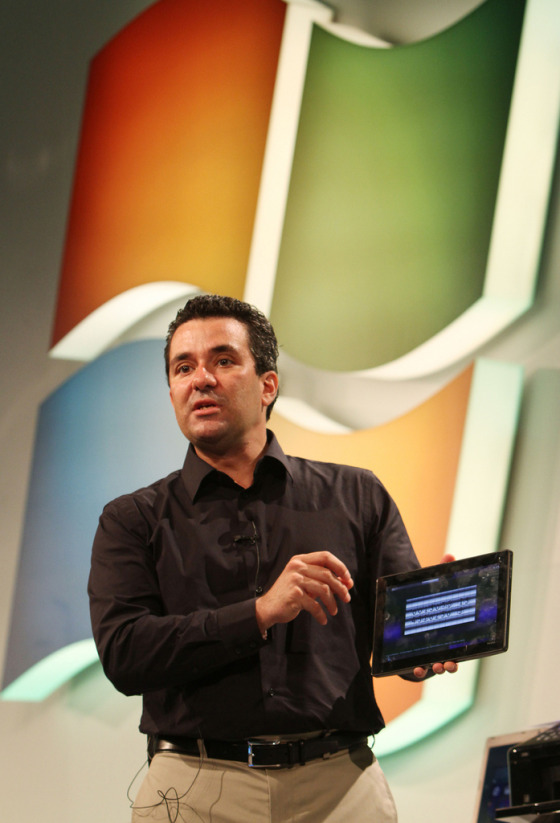Windows 8 revealed!!
 Matthew Kopelke |
Matthew Kopelke |  Thursday, June 2, 2011 at 9:30PM
Thursday, June 2, 2011 at 9:30PM  Image courtesy of Microsoft
Image courtesy of Microsoft
Yesterday Microsoft unveiled to the public the first glimpse of what Windows 8, the next version of their highly successful operating system, will look like. As you can see from the above image, it’s going to be quite different from the look and feel introduced in Windows Vista, and then further refined in Windows 7. The goal here on the part of Microsoft would appear to be to position Windows 8 as their single OS for desktops and laptops, as well as the emerging tablet PC market that is presently dominated by Apple’s iPad. While it’s quite clearly still in an alpha phase of development (the demo at the All Thing’s D conference didn’t go into a huge amount of detail), what we have seen already looks gorgeous, seems very responsive, and best of all is so much more touch-enabled than anything Microsoft has released previously as a mainstream desktop operating system.
For anyone who has used a Windows Phone, then the new look UI for Windows 8 shouldn’t be too shocking. This is a Metro UI, the same tiles-based interface Windows Phone users have been loving for well over 6 months now. The single biggest benefit that a Metro UI has, over anything that either Apple or Google are offering today, is the ability to mix application icons with tiles that contain real-time information. As you can see above, not only can the user directly open an application, say Internet Explorer, but they can also see their next calendar appointment, or what the current local weather situation is like, or what their latest e-mails might be. The possibilities are endless with Metro, and this whole notion of “glance and go” is a revelation after years of working with static icons arranged in a grid, like they are on iOS and Android. Microsoft really are onto a winner here with Metro.
A lot has been said in the press in the last 24 hours that this should only be considered a shell, sitting on top of “regular Windows 7”. And yes, while that could be seen as a valid observation given there is a “Desktop” tile on the new Start screen, and the demo of Office 2010 showed that the Windows 7 environment was definitely present, I think that there are a few issues with this concept. Firstly, I see this “Windows 7 Mode”, such as it is, as nothing more than a way to offer backwards compatibility for applications not developed for the new Metro UI. This has a parallel already in Windows 7 - Windows XP Mode is a present feature, designed to allow you to run legacy Windows XP applications that don’t work under Windows 7. What this says to me is that yeah, sure, when you first buy a Windows 8 PC you will probably find yourself running some programs in the old UI, and that will certainly be jarring. But as time goes on, and the new Windows 8 Marketplace fills up with new applications designed for the new Metro UI, you’ll almost certainly spend more and more time in the new design language, going back to your legacy applications less and less. My prediction is that Windows 9 will be Metro UI only, with my legacy desktop access available.
A second thought around this line occurs, and it’s to do with business / enterprise adoption of Windows 8. If there’s one thing that Microsoft knows, it’s that making any major changes to Windows always sees a drop-off in business adoption in the first 12 - 18 months. Witness what happened with Vista as proof of that (although Vista did suffer from a horrible anti-PC marketing campaign courtesy of Apple). By assuring business customers that Windows 8 will definitely still run legacy Windows 7 applications, Microsoft are probably hoping to have the best of both worlds. Consumers will buy Windows 8 in droves, while business / enterprise customers wil hopefully still upgrade (either to get the new UI, or simply lock it down to the classic look to maintain compatibility). I guess the hope is that by the time Windows 9 comes out in 2015, enough people will have gotten used to Metro to get rid of “Windows 7 Mode” entirely.
 Image courtesy of Microsoft
Image courtesy of Microsoft
There’s been some commentators who have said that Windows 8 is more akin to the strategy Microsoft employed with Windows Mobile 6 - stick a skin over the top of the ugly bits, and hope that is enough. And while this does have some similarities to something like HTC Sense, there is one crucial difference - developer support is present for Windows 8, which never was for something like TouchWiz or HTC Sense on Windows Mobile. Since developers will be able to write applications for Windows 8 that will be native to Metro, there’s no reason why a brand new Windows user couldn’t live solely in the new UI, and never have to drop back to the Windows 7 desktop to run an app.
My only reservations for Windows 8 comes around multi-tasking. With the loss of the Windows taskbar, I am worried that multi-tasking could become a bit more difficult. I guess we will have to wait and see, but at least they’re innovating their Aero Snap feature in Windows 8 to allow easy side-by-side application access. I am also really pining for some proper Australian love with Windows 8, and that we don’t get a crippled set of services surrounding the new OS. With Windows Phone, we’re still waiting on full Zune store access, as well as the full feature set of Bing services down under. Let’s hope that Windows 8 redresses the balance, because Microsoft really have a great chance here to bring the fight to Apple by making Windows 8 feature complete down in Australia.
I must be honest - while I do love the Aero Glass look of Windows 7, I am a huge fan of the Metro UI on Windows Phone. I am very eager to get my hands on a Beta version later this year, and try it out. It’s great to see Microsoft finally coming out with a coherent Tablet PC strategy, particularly so when you consider that Microsoft have been pushing this idea for nearly a decade. While they are “late” to the Tablet PC market in modern terms (much like they were with smartphones), I think Windows 8 has a lot of promise and potential. The only thing that will ensure success or failure for Microsoft is developer support for Metro UI. Even here, though, I am confident. Microsoft are going very well with Windows Phone, adding around 80-odd new applications a day to the Windows Phone Marketplace. If they can have the same level of developer adoption for Windows 8, then this will be a great starting point for the biggest change to Windows since the launch of Windows 95.
 Image courtesy of Microsoft
Image courtesy of Microsoft
 Gadgets
Gadgets 

Reader Comments